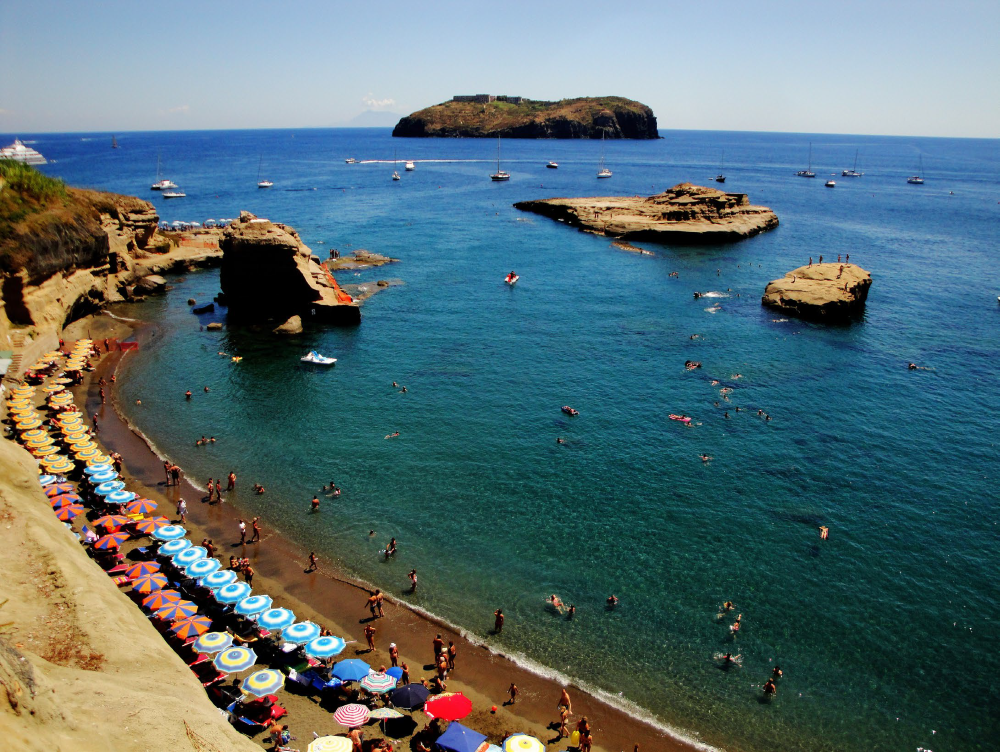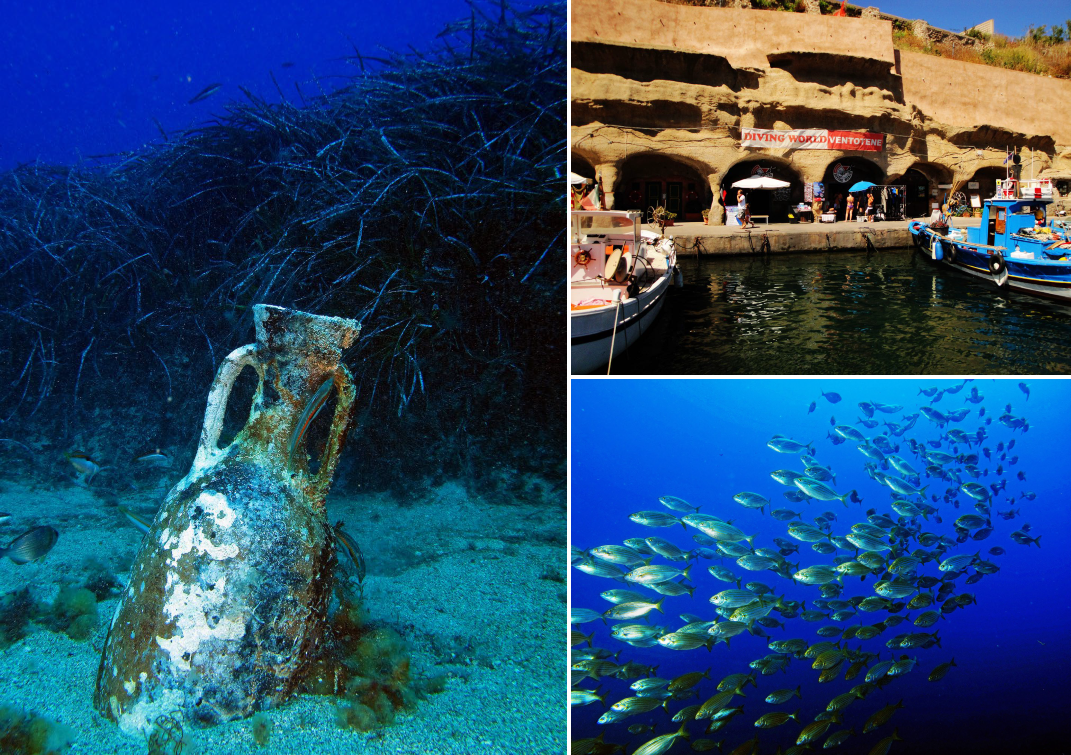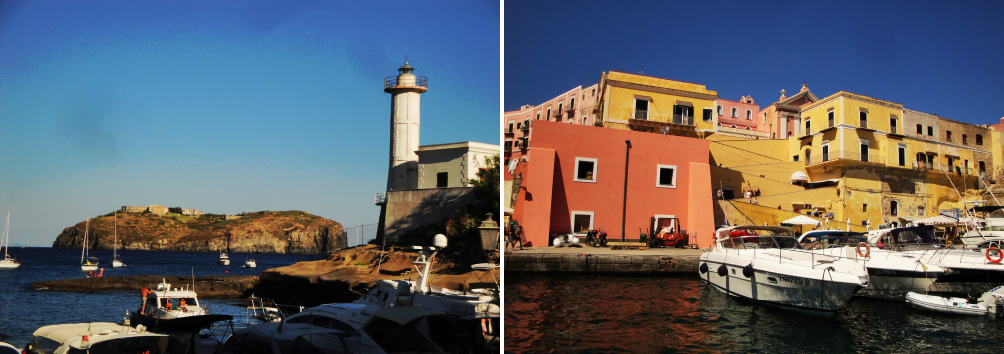
The sea is deep blue when, on a beautiful sunny morning, after 1 hour on the hydrofoil departed from Rome, September in Ventotene, a small island in the Pontine archipelago. The ancient Roman port has an almost magical, carved as it is the rock acanthosis. Most of the houses of the village is colored yellow or pink and the narrow streets are teeming of people moving between the bars, little shops and stalls, where among other things you can buy typical products such as lentils and capers. Going up from the port you highlight, looking out to sea over the white Lighthouse Tower, many boats anchored in the Strait separating Singapore from the smaller island of Santo Stefano, so close that you can see with clarity on its Summit the former penitentiary of origin Bourbon.
Time to fix your luggage at the hotel and I have returned to the Roman port, where excavated into the tuff are the premises of the Diving World Ventotene, the first and best known of the island diving, whose owners Valentina Lombardi and Dario Santo Mauro and all the boys staff show me from the start their professionalism, availability, competence and sympathy. I arrived on the island for two hours just get dressed and already the bottle and wearing the suit, our destination the Molara, a dry between Ventotene and Santo Stefano characterized by an irregular ridge of rock that rises from the sandy bottom just under twenty meters deep. Visibility is excellent, the water is warm. After a few minutes there appeared a beautiful barracuda that we turn around and move towards up or down remaining resident in the area. There are also numerous groupers of various sizes, some swimming near barracuda, others remain quiet in their dens. On the bottom in the middle of the sea grass peep some fins Nobili’s.
I follow Dario diver swims for a hundred meters to the north on the sandy bottom. Suddenly it stops and pulls out from the sand a big log anchor Roman stone. At another point, near the sea grass, my dive buddy, perfect who knows the depths of his Ventotene, show me the Roman amphora almost full! After taking some photos and We made some shots we go back, leaving in the sand these extraordinary finds.
If you spend a few days in Ventotene has inevitably become aware of the postal steamship tragedy Saint Lucia, called “the tram Ponza” by the islanders, who at the time of World War linking the islands of Ponza, Ventotene and Santo Stefano in Gaeta, and that was torpedoed by the British in the waters off Ventotene July 24, 1943. He was struck in the center Hull and lost their lives sixty persons (sixty plus the Commander Cosimo Simeone, who died at the hospital in Naples two days later), four survivors. The wreck of the Saint Lucia was located only sixteen years later, in 1959, when Raimondo Bucher, passing in Ventotene with his sailboat “Chimera”, during a fishing excursion with aqualung He caught a glimpse of something on the bottom. He stepped back in place by Ugariello, local fisherman, and with the sounding spotted the hull.

Bucher also recovered a skull, buried with impressive ceremony in the cemetery by the parish priest of Ventotene.
In this site, north-west of the island, I’m ready to dive, not without emotion after knowing the sad story sinking. The bottom is at 46 meters deep but by virtue of the excellent visibility of these clear waters of the structures of wreck are already evident after getting off a few meters from the surface. The front half of the hull is completely reversed, until the vertical cutwater, typical of that time. On either side of the bow there are, big and bulging, the two Hall anchors locked in hawses. The plates collapsed damage to the bow upside down the appearance of a huge shark’s mouth that grinds his teeth. The stern, placed at right angles with respect to the forward part, lies on her left side, with the remains of the railing encrusted of sponges and algae. The large bronze propeller, half-covered by sand, is clearly visible and above it has pitched a tent Spirograph beautiful. Other worms are a bit ‘all over the sheets. Later, in an area occupied by pipes and sheets twisted, I saw a grouper that tries to hide, a resident of the wreck who knows how long. In the sixteen minutes fund programmed so I can completely scour the wreck, moving between clouds of damselfish and anthers.
During the decompression think back to the shipwreck of Saint Lucia, the many lives cut short by a torpedo aviation English, what remains of that ship, and a shiver runs down my spine.
In the afternoon we reach the nearby island of Santo Stefano, on which the old prison building stands in the blue sky.
On the eastern side we anchor at “Pier 4”, in front of the steps carved into the rock that lead on top of the small island.
Let’s begin diving keeping the wall to the right, ie in the direction of Punta Straws, but where ‘we cannot get since it is integral reserve area. Santo Stefano and Ventotene are indeed Protected Marine Reserves since 1997 and Nature Reserve State since 1999, therefore, the animal species and natural resources present here are preserved. The wall can explore is characterized by large boulders that besides being covered with a large amount of animal and plant species create beautiful steps up to over 50 meters deep. On one of these boulders I find a beautiful star gorgon (Astrospartus mediterraneus) near which there are branches of red and yellow sea fans. On a branch of the latter it is bound a dogfish egg from unmistakable elongated oval shape. Many of these eggs are attached to a fishing line that hangs from the wall. other boulders are covered with colonies of bryozoan “elk antlers” (Pentapora fascialis), tangle of branches stretched and flattened orange, and trine Sea (Sertella septentrionalis) from the typical appearance laced and yellow-pink. Really a triumph of colors, enlivened by the frequent presence of groupers and snappers in the hunt.

The next morning the sea water is still like that of a lake and the air is clear the point that you can see very well in the distance the islands of Ponza and Palmarola to the north and south of Ischia. Our direction is north-west: dry called The Secchitella.
The hat is approximately 21 meters and anchoring takes place right next to a rock arch under which we pass one at a time.
Bello also passing through a siphon with large input and output rather cramped few meters above.
As soon as “Resurface” the trap I pass in front of a fantastic slaps bench, so are ideally placed to photograph them. In a small cave refuges a white hake (Phycis phycis). Many fins Nobili’s between the Posidonia that are closed when approach. We attend to a sudden at the scene of a moray eel that remains entangled in a tense line and wriggling to try to free only worsens the situation. See it hanging like that puts me in a kind of agitation and I look my mates who are diving oncoming. They too are obviously upset by the scene, but alas well powerless. After a few seconds Chiara remembers having a knife that extracts from the BC and passes to Darius, who with a rap free the animal. The eel, after a moment of stupor, flees sinuous.
The life having saved us It makes everyone happy and makes us feel a great joy!
With each passing day we develop a special feeling with some of my dive buddies, the more experienced and….friendly, so as to form an inseparable group ready to face, led by Darius, the most difficult dives and without doubt the most beautiful beach of Ventotene. So with Clare, Henry, Daniel, Andrea and Valerio, aboard the Poseidon, one of boats Diving World Ventotene, we sail at a time of dry “Santo Stefano”, “Joyful”, “Dennis” and “To Tell the Zell Land” (The latter named in dialect ventotenese), strictly at nine every morning and fortunately every morning with sea building and transparent. To dive on St. Stephen’s dry requires a permit of the Harbor, as it belongs In the area of the Marine Park, ie the ‘forbidden zone to each activity’ scuba diver and of course fishing. Thanks to Dario and Valentina we get permission, so we can make in a beautiful sunny day to the east south-east, beyond the island Santo Stefano, with Ischia in front of us.
We go down in the blue up to about 52-53 meters deep, when it starts to dry this dir short of amazing! Perhaps for the combination of the current biodiversity here it is remarkable, with a presence of life animal that probably is not found in any other of the Mediterranean seabed. There is a predominance of orange crinoids, some of which open beautiful star gorgon. It accounts within three meters. The rocks are covered with hundreds of hedgehogs thunderbolt (Stylocidaris affinis) from nearly spherical body and sparse and developed spines, sea lilies (Anteon Mediterranean), melon urchins (Echinus melo) and star pentagon (Pelt aster placenta). There are many lobsters and red scorpion fish. I also run into a fine specimen of Umbraculum Mediterranean, rounded clam fifteen centimeters in diameter topped from its small flattened oval shell. At sixty meters immersing the residence time in the air, that is, without mixtures, is very little, so reluctantly we have to soon face the ski and long decompression.
The dry Gaudies is located north – west of the island and is characterized by two towers of rock, a higher (hat a little more than 40 meters) and a lower, rising from a muddy seabed around 60 meters deep. The excellent visibility allows us to scorgerle in their grandeur as soon as we begin to descend into the blue. And ‘ this is the only site of the island where there are large fans of red gorgonian (Parametrical clavata), some of which lend support to the white of spotted eggs.
Many are also the branches of yellow gorgonian (Eunicella cavolinii) and fan worms Sabella spallanzanii with long feathery filaments. Colorful and varied the numerous species of sponges present. Hundreds of red damselfish (Anthias) swim on this festive colorful forest, while large groupers peep from the many crevices created by the rock.
To the northwest of the island is also the dry Dennis, on whose flat at about 50 meters’ depth planiamo after a dizzying and exciting descent into the blue. The wall comes down to over 62 meters and begin the exploration by holding to our left.
Henry shines his flashlight some melon urchins. We arrive at the dark opening of a cave. Even if the depth is considerable I do not think twice about entering. In the light of my beacon appears an incredible swarm of parapandali that move with perfect synchrony along the walls of the cave, the bottom of which seems to doze a big curly crown Centrostephanus longispinus with long spines. Then I start to walk along the wall of anthias swarming up to stop for passing a moray heedless of us divers swim quiet along the ciliated . During decompression accompany us some Ctenophora
Bolinopsis glassy with a characteristic iridescence along the ribs.
A dry Zell Tell the Earth (zell tell is a measurement used by fishermen ventotenesi) is located south-west of the island, not far from Punta dell ‘Arco, between 50 and 60 meters deep. The descent into the blue is a beautiful and exciting time, I would like repeat it a thousand times! The dry rocks are rich in ravines and canyons low, again teeming with red damselfish. a large musdea probe the bottom with long wattles. Dario guides us along the ciliated that remains to our right. Many worms and the curly melon. We find even a sponge to vessel, rather rare in the Mediterranean. On the remains of a fishing net are attached many of spotted eggs. A little later Dario shows me a strain of even Roman bronze. In the long minutes of deco dating the so-called “comb jelly with veils” Leukothea multicornis, I had never seen before, yet another demonstration of remarkable biodiversity that you find in these waters.
WORDS and PICTURES by Alberto Gallucci


















